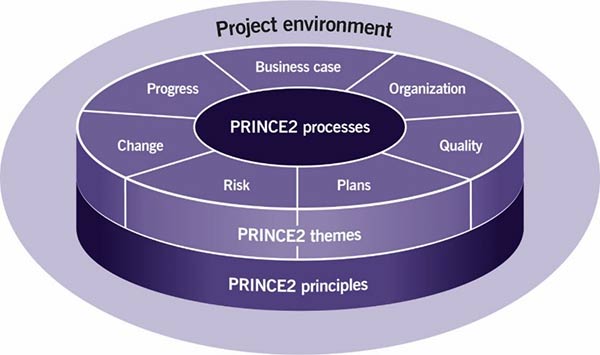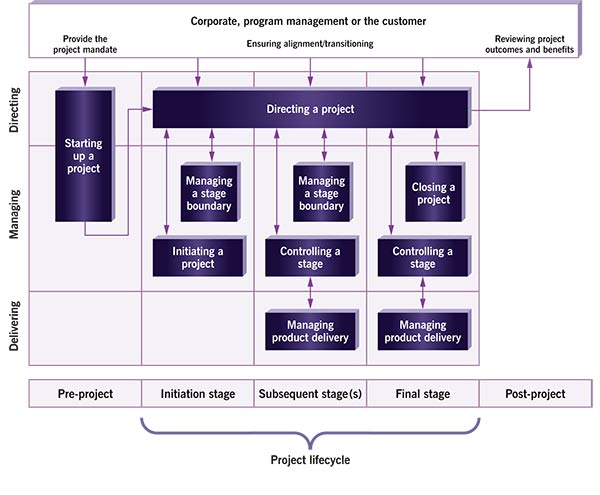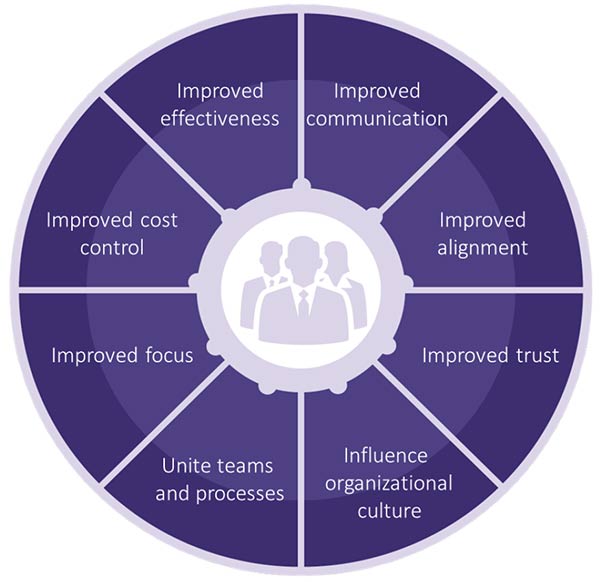Effective Project Management: Why the PRINCE2 method is more relevant than ever
White Paper

White Paper
- White Paper
- Project management
- Collaboration
- Communication
- Business solutions
- Governance
- Project planning
- PRINCE2
September 25, 2020 |
15 min read
- White Paper
- Project management
- Collaboration
- Communication
- Business solutions
- Governance
- Project planning
- PRINCE2
Many organizations are driven by projects. Projects help us to create new products, implement improvements, retire legacy systems, and much more. Project management, therefore, is often an integral part of business.
PRINCE2 is a world-leading project management method. It not a prescriptive set of rules, but rather a flexible, principle-driven approach that is designed to be tailored to every individual situation. No two projects are the same, but you can ensure consistently excellent results using the PRINCE2 method. This paper explains why.
Introduction
The PRINCE2® method is more relevant now than ever for project management professionals in all sectors and across all geographies. This paper explores why by focusing on:
- How it has been developed over time to become a key part of the Axelos portfolio.
- What it is and how it works.
- Why it is universally used.
- The power of the principles, which are universal, are applicable to every project, and drive the method.
- The strength of the themes that are integrated and addressed continually throughout the project.
- The logical and effective processes, defining the project lifecycle from beginning to end.
What do Axelo products do?
The Axelos product portfolio, including PRINCE2, provides effective practical guidance and the endorsement of acquired knowledge, which can be used to develop skills and processes. This is supported with case studies and testimonials from end users.
The content developed by Axelos is distilled from real-world experience and developing practices. Based on robust reviews with the Axelos ecosystem and detailed guidance updates by subject matter experts, Axelos content is in constant evolution. Its development shows that collaboration runs through the heart of everything that Axelos does.
The certifications endorsed by Axelos distinguish individuals as knowledgeable professionals in a specific area of expertise, instilling confidence and empowering them to succeed. Any professional with the designations of the PPM portfolio will be able to:
- deliver consistent results and reduce costs
- ensure the organization makes good investments
- improve speed-to-market by increasing efficiencies
- improve customer and stakeholder satisfaction
- provide a competitive advantage
- apply knowledge of a range of delivery modes: including agile, linear, and hybrid
- understand and provide governance and deliver successful change
- be a key player for change within an organization.
Equipped with the above, individuals can simultaneously boost their careers and help their organizations achieve better outcomes.
What are projects?
Projects have been with us since the dawn of civilization. Throughout history, projects have allowed organizations to produce new products or capabilities, resulting in change. Other examples where project management is required include:
- marketing campaigns
- product development
- setting up a new internal process
- responding to regulatory and legislative changes.
What is the PRINCE2 method?
With roots dating back to the mid-1970s, PRINCE2 has been with us since 1996, providing a method for effective project management and continuous development for project management practitioners for over 20 years.

Figure 4.1 PRINCE2 timeline
The PRINCE2 method helps to successfully deliver projects of any size or complexity because it is generic and universal by design. This is a key feature of PRINCE2. Built from a wealth of experience, the method provides the essentials for managing any kind of project. As the leading global method for project management, it is implemented across a wide range of industries and sectors, standardizing roles, language, and processes for organizations and professionals alike.
The PRINCE2 method keeps project managers on track. It ensures acute control on the key elements of any project: cost, time, quality, scope, benefits, and risks and drives improved communications with stakeholders and within teams. The method is flexible, scalable, and tailorable for each project. It is designed to contribute to the success of a project without burdening it with bureaucracy.
Consisting of guidance, training, and a professional certification, PRINCE2 represents the ‘how to’ of project management. The method addresses project management the four integrated elements of principles, themes, processes, and the project environment.

Figure 4.2 The structure of PRINCE2
4.2 PRINCIPLES
PRINCE2 is a principle-based method rather than a prescriptive one. The principles provide a structure of best practice for people involved in a project and were developed from lessons taken from both successful and failed projects. The principles are:
- Universal: they apply to every project.
- Self-validating: they have been proven in practice over many years.
- Empowering: they provide confidence to practitioners and the ability to influence and shape how the project will be managed.
The seven principles are:
- Continued business justification: which requires a justifiable reason for starting the project. This justification is revalidated throughout the lifecycle of the project.
- Learn from experience: when starting a project, lessons from previous or similar projects should be reviewed and applied. This is especially important if a project of this complexity and size is being conducted for the first time, and the project should consider learning from external sources.
As the project progresses, the project team should continue to seek opportunities in implementing improvements during the project lifecycle. It is the responsibility of everyone on the project to look for lessons. Those lessons should be logged as the project closes. - Defined roles and responsibilities: a PRINCE2 project has defined roles and responsibilities within an organizational structure that engages the business, user, and supplier stakeholder interests. The business endorses the project objectives and ensures that the business investment provides value for money. Users will use the products after the project has been completed, enabling the organization to realize the expected benefits. Suppliers provide the resources and expertise required by the project and can be internal or external to the organization.
- Manage by stages: PRINCE2 breaks the project down into discrete, sequential management stages.
The more complex and riskier a project is, the more management stages will be required. The choice of appropriate management stages for a project will depend on:- size and complexity
- decision and control points
- organizational standards.
- Manage by exception: a PRINCE2 project has defined tolerances for each variable (cost, time, quality, scope, benefits, and risk) to establish limits of delegated authority. The project board delegates the authority for the daily running of a management stage (within agreed tolerances) to the project manager. If the management stage is forecast to remain within tolerance, then the project manager has discretion to make adjustments as required. This allows the project board to manage by exception. This implementation of ‘manage by exception’ is an efficient use of senior management time as it reduces the senior managers’ time burden without removing their control by ensuring decisions are made at the right level in the organization.
- Focus on products: a PRINCE2 project focuses on the definition and delivery of products, especially their quality requirements. Under this principle, PRINCE2 requires projects to be output-oriented rather than work-oriented. PRINCE2 calls these outputs ‘products’. A product is an input or output (tangible or intangible) that can be described in advance, created, and tested. PRINCE2 has two types of products: management products and specialist products. This separation is another key feature of the method.
- Tailor to suit the project: PRINCE2’s great value is that it is a universal project management method that can be applied to take account of the project’s environment, size, complexity, importance, team capability, and risk and can be used for any project type, geography, or culture. It can be used on any project because the method is designed to be tailored to suit the project context. The purpose of tailoring is to ensure that:
- the project management method used is appropriate to the project (e.g. aligning the method with the business processes that may govern and support the project such as human resources, finance, and procurement).
- project controls (e.g. the frequency and formality of reports and reviews) are appropriate to the project’s scale, complexity, importance, team capability, and risk.
4.3 THEMES
The themes describe aspects of project management that must be addressed continually as the project progresses through its lifecycle. The seven themes are shown in Table 4.1.
| Theme | Description | Answers the question | Chapter |
|---|---|---|---|
| Business case |
The project starts with an idea which is considered to have potential value for the organization concerned. This theme addresses how the idea is developed into a viable investment proposition for the organization and how project management maintains the focus on the organization’s objectives throughout the project. |
Why | 6 |
| Organization | The organization commissioning the project needs to allocate the work to managers who will be responsible for it and steer it through to completion. Projects are cross-functional so the normal line function structures are not suitable. This theme describes the roles and responsibilities in the temporary PRINCE2 project management team required to manage the project effectively. |
Who? | 7 |
| Quality | The initial idea will only be understood as a broad outline. This theme explains how the outline is developed so that all participants understand the quality attributes of the products to be delivered and then how project management will ensure that these requirements are subsequently delivered. | What? | 8 |
| Plans | PRINCE2 projects proceed on the basis of a series of approved plans. This theme complements the quality theme by describing the steps required to develop plans and the PRINCE2 techniques that should be applied. In PRINCE2, the plans are matched to the needs of the people at the various levels of the organization. They are the focus for communication and control throughout the project. | How? How much? When? |
9 |
| Risk | Projects typically entail more risk than stable operational activity. This theme addresses how project management manages uncertainty. |
What if? | 10 |
| Change | This theme describes how project management assesses and acts upon issues which have a potential impact on any of the baseline aspects of the project (its plans and completed products). Issues may be unanticipated general problems, requests for change or instances of a product not meeting its specification. |
What is the impact? | 11 |
| Progress | This theme addresses the ongoing viability of the plans. The theme explains the decision-making process for approving plans, the monitoring of actual performance and the escalation process if events do not go according to plan. Ultimately, the progress theme determines whether and how the project should proceed. | Where are we now? Where are we going? Should we carry on? |
12 |
Table 4.1 The seven PRINCE2 themes
A great strength of PRINCE2 is the way in which the seven themes are integrated, and this is achieved because of the specific treatment of each theme. How the themes are applied can be influenced by tailoring. This may range from being rigid and prescriptive through to allowing the project management team a large degree of freedom in how they implement each theme.
All of the seven themes must be applied in a project, but they should be tailored according to the risk, scale, complexity, or simplicity of the project concerned and contained in each theme chapter. Tailoring allows the themes to be adapted to create appropriate procedures and controls, provided that:
- the principles are upheld
- the minimum requirements in each theme are satisfied
- the purpose of each theme is not compromised.
It is important to note that the processes, procedures, and controls through which themes are implemented can become complex and prescriptive. This often creates an unnecessary burden on projects and seldom provides greater control. It is usually better to keep processes and procedures as simple as possible and ensure the project management team really knows how to use them. The more knowledgeable the team, the lighter the processes, procedures, and controls can be. It is better to coach people in using a process or procedure than to keep adding more detail in the hope they will understand it better.
To ease understanding, the chapters in the PRINCE2 manual have been structured as follows:
- Theme: Why the theme is important to the successful delivery of a project and the core concepts necessary to understand PRINCE2’s requirements for the theme.
- PRINCE2’s requirements for the theme: What is required, as a minimum, to be following the PRINCE2 method.
- Guidance for the effective use of the theme: How to practically apply the theme to different organizations, environments, and delivery approaches.
- Techniques: Techniques that can be used for the theme.
4.4 PROCESSES
PRINCE2 is a process-based approach for project management. A process is a structured set of activities designed to accomplish a specific objective. It takes one or more defined inputs and turns them into defined outputs.
There are seven processes in PRINCE2, which provide the set of activities required to direct, manage, and deliver a project successfully. These are shown in Figure 4.3.
Figure 4.3 The PRINCE2 processes
The project board sets the direction and makes key decisions throughout the life of the project. The project board activities are covered in Chapter 15 of the PRINCE2 manual and runs from pre-project through to (and including) the final management stage. It is important to note that the ‘Directing a Project’ process in chapter 15 is further explained and supported by guidance contained within Directing Successful Projects with PRINCE2® (AXELOS, 2018). It is important for organizations to use both the core PRINCE2 manual method and this guidance to fully support the work of project boards.
Particular care must be taken during the start-up of the project stage; if this is done badly, the project is likely to fail further down the lifecycle.
4.5 BENEFITS TO ORGANIZATIONS
PRINCE2 benefits organizations by:
- Providing a centralized approach to project management: which results in consistency, clarity, and efficiency for the organization’s projects.
- Ensuring business justification: a standardized approach to managing time, risk, cost, benefits, scope, and quality which ensures that the resource is justified and return on investment is consistently measured.

Figure 4.4 PRINCE2 benefits to organizations
Other benefits to organizations are shown in Figure 4.4
4.6 BENEFITS TO INDIVIDUALS
PRINCE2 benefits individuals by providing:
- Step-by-step guidance: ensuring project managers have an effective and efficient team structure, relevant planning, and manageable stages to deliver their project on time and within scope and budget.
- An accessible way to boost their resume: the PRINCE2 certification has no prerequisites, which means project managers can sit the certification at any point in their career, without waiting to reach a certain level of professional experience.
- The means to effectively plan, delegate, monitor, and control their work. It also supports them with their demanding role using health checks and a process-based method which follows the project lifecycle.
4.7 WHAT IS THE APPEAL OF THE PRINCE2 METHOD?
The PRINCE2 method exists within the context of several standards and bodies of knowledge, including:
- ISO 21500:2012: guidance on project management which is the global standard.
- BSI 6079 2019 Project Management: principles and guidelines for the management of projects.
- PMBOK Guide, 6th edition: A Guide to the Project Management Institute Body of Knowledge from PMI.
- APMBOK 6th edition: APM Body of Knowledge.
PRINCE2 also has considerable synergy with ITIL® 4, the best practice framework for IT and service management.
The method provides the following for organizations:
- helps to successfully deliver projects of any size or complexity because it is generic in nature
- applicable to a wide variety of industries and geographies
- built from a wealth of experience, being continually evolved over a period of more than 20 years
- provides the essentials for managing any project.
Conclusion
PRINCE2 is a logical, principle-driven method that follows the project lifecycle and by doing so, mitigates the fear that often surrounds projects and the introduction of change into an organization.
Recent research* shows that project management professionals are needed now more than ever, with the ever-increasing demands for change from organizations and the expansion of project management into industries such as Healthcare, Publishing, and Professional Services. From 2017 to 2027, the biggest increase in project management jobs in project-oriented industries will be in India, China, and the US.
With over one million certification professionals in over 150 countries, it is the world’s most widely adopted project management certification. It has seen an evolutionary process of robust review and revision, resulting in the formation of the current product. There are numerous PRINCE2 case studies, demonstrating how the method can be put into practice and these continue to grow. In these uniquely uncertain times of social, political, and environmental instability, PRINCE2 provides organizations and individuals with the confidence to introduce change and achieve successful outcomes.
* Source: PMI (2017). Project Management Job Growth and Talent Gap Report 2017 to 2027. Web. Available at: www.pmi.org/learning/careers/job-growth [Accessed 24 September 2020]